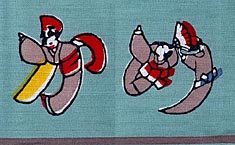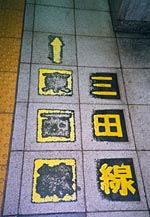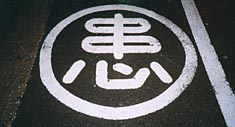
< back to kame in january
2000
< back to home
> see related history
(october)
> see related research (october)
after a while, kanji does get easier...
even after millions of rush-hour shoes,
the obliterated characters on the left still say
"tou-zai-sen" (east-west-line)
scroll at yoshino-yama's yoshimizu-jinja shrine, where kame greeted the first morning of the year 2000:
"The panel [...] says that it was 'presented to
Emperor Godaigo', the 96th Emperor, reigned 1318-39.
Probably the key to an encryption as you guessed, but it looks like a music
score to me."
- Akira Kobayashi
kushi-shin or kushi-kokoro? --
"skewer-heart" on a parking space?
"The white letter in a circle is not 'kushi-shin', nor 'kushi-kokoro'. It is not two separate letters, but A SINGLE kanji -- it is a sign of 'parking for ambulance'. I believe there was a hospital nearby. The letter is "kan" for "kanja". Kan (ill) plus ja (person) means patient.
Why skewer-heart? My dictionary says, the upper-half represents seashells strung together. Making a hole to put a thread through often damages seashells. Placing it ['damaged'] upon 'heart' becomes "ill". You know that seashells were used as coins in ancient China."
- Akira Kobayashi

jinbutsu-iroha:
human alphabets were the rage in the edo period, and so pleasantly different
from their western counterparts...
an old woodcut (right),
and a new but hand-printed 'tenugui' handkerchief from 'kamawanu' in daikan-yama.


t y p e - g a m e s

